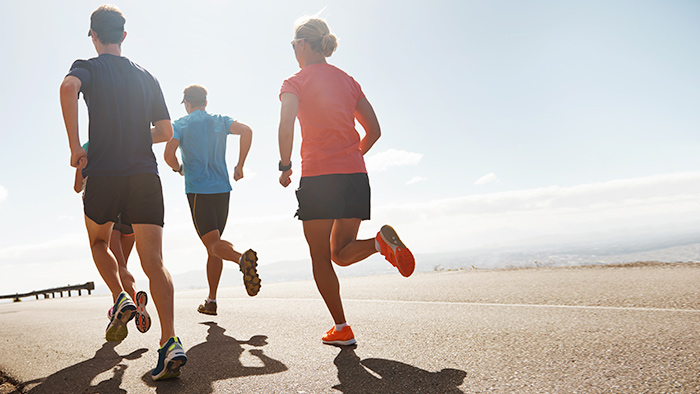As we soldier through the cold winter months, the reduced daylight hours and variable weather systems can take a toll on an athlete’s mental and physical performance. Traveling somewhere with different climate and terrain and putting in a pile of outdoor miles becomes appealing. Training camps are a great motivator for getting a jump on the year. However, it is important to keep purpose and the phases over your year-long program in mind before heading for warmer climates.
Training camps can fall into a number of categories: learning, mileage, race specific preparation and acclimatization. These getaways can be on your own, with a bunch of friends or attending one of the many professionally coached camps available. For those thinking of a March or April training camp, race season can still be three to five months away, and arriving at the camp as a direct fitness builder to competition shape is not the right approach. The early season is an excellent opportunity to transition the body and mind in a positive training environment away from the confines of busy work days, limited hours and possibly not the best sleep. Connect with your inner athlete: The valuable training days can be focused on the training and necessary recovery, without the distractions of other day-to-day tasks. If traveling with a family, have frank and honest discussions while planning the camp before actually leaving, so that you can make time available for tourist activities and quality family time.
Often these early season camps focus on getting comfortable with outdoor activity in the warmth. They can have an emphasis on one sport or a balanced, three-sport plan. Try to avoid going hard in all three or increasing overall volume to twice what you are used to at home. That is a recipe for injury or a quick burnout.
Location and Logistics
This may sound obvious, but if you are planning your own camp to work on cycling skills, make sure where you are going is conducive to cycling and has a variety of roads and terrain suitable for what you plan on doing. Pay particular attention to general weather forecasts—even southern locations can have wet or cold weather in March and April. Check out training courses and terrain in the area you will be visiting. Also, if you need help reassembling your bike after travel, research availability of a nearby bike shop—they can also provide a wealth of local training knowledge. Swimming logistical planning involves confirming access to a pool where there are no conflicts with competitions or school groups. We have heard stories in the past where athletes have arrived at a pool only to find a local swim program has all the lanes booked. Check out local open water swimming opportunities as well, but make sure to consider safety if you will be swimming alone.
Travel Tips
There are many benefits to booking flights early. Not least is choice of airlines, especially those that have minimal fees for extra or oversize bags and bikes. Booking early can also mean you secure the most flyer-friendly routes to your destination, which is of particular importance for long-distance travel. You will also want to minimize the transfers and layovers as much as possible. Online booking often includes overnights at airports to keep costs down. Be aware of to avoid being caught by surprise. You don’t want to lose training camp days camping out at airport hotel en route. Popular destinations over school breaks can often deplete the supply of larger vehicles necessary for moving gear around easily. Avoiding popular travel times can keep down costs dramatically.
Bring food with you on the flight if you can. Try to rely as little as possible on restaurants at the airport. Wear compression socks to maintain good blood flow in your legs during the flight. Bring hand sanitizer and your own electrolyte drink. Make an effort to to drink plenty of water, it can be helpful to set your watch or smartphone with reminders to drink every half hour. If traveling over multiple time zones, change your watch to the destination time zone as soon as you get on the plane. If you are sitting next to a person that seems to be sick, ask to be reseated if possible. Have a predominantly carbohydrate-based meal early in the flight to help with sleep and a largely protein based meal close to arrival to perk you up. Avoid alcohol and try to stretch and walk around frequently if you are not sleeping.
Food Considerations
Athletes can be surprised by the local cuisine at their destination, especially when traveling outside of the continental U.S. Research where you can find a grocery store, and if they provide food that you are accustomed to. Choose a lodging that has a kitchen of some sort. Pack some of your favorite training recipes and decide whether you need to bring some food with you from home. If you do this you will need to find out the restrictions on food for the airline that you are traveling with. The same goes for your workout nutrition. If you have a favorite brand of gels or bars it makes sense to bring a decent supply for the week. That way one isn’t left scrambling or just making do and risk poor training performance and recovery.
Clothing For All Conditions
Comfort while training can make or break an athlete’s experience. Bring gear that you are used to wearing, and at least two of each of the major garments (jerseys and bibs for cycling, and a run top and shorts for running, etc.) so you can wash one set while the other is being worn. Being too cold or too warm can negatively affect performance, so layers allow one to shed partial coverage. Pack for cold weather even if you don’t anticipate it. I once ran a Hawaii camp that was cold and rainy for eight straight days! IRONMAN champion (and frequent traveller) Brent McMahon shared this tip: When laying everything out before packing, begin at the top of the head and work your way down to your feet, starting at the inner layer and ending with outerwear.
This is a useful, general overview of the logistics that go into attending a winter training camp. Be prepared by using lists provided by camp organizers or creating your own from past experience. Taking the time in advance removes guesswork and will make your camp time that much more effective and enjoyable.



